Ceasefire or wise-guy deal or... no deal at all?
If you have even the slightest interest in international politics, you've heard the news.
As of yesterday… the ball is in Russia’s court.
As in Ukraine has agreed to a ceasefire. Or the concept of a ceasefire. Which is in itself confusing—as are the various interpretations of this game of strategic negotiating that is meant to be a first step to end the war.
Some have stated that the US-Ukraine agreement to agree has effectively called Russia’s bluff. Others have claimed that Ukraine called the US’s bluff (these being the anti-Donald Trump contingent) and that the US president will soon learn that Putin (through Foreign Minister Sergey Lavrov) is a difficult negotiator who rarely in fact agrees to anything at all.
But before we get into the will-Russia or won’t-Russia argument, let’s backtrack a bit and examine why the “rare-elements” deal may not be what even Trump really wants or needs if he is sincere about avoiding World War III.
A wise-guy deal…
Much of the world (including centrist Republicans in the US) were appalled during the much discussed meltdown of a meeting on live TV that included Ukrainians President Volodymyr Zelenskyy, Trump, US Vice-President J.D. Vance and US Secretary of State Marco Rubio—who himself was once known as a stout defender of Ukraine.
Since the meeting various pundits have claimed that 1) it was a trap for Zelenskyy or 2) that Zelenskyy handled it badly in that he at least could have brought an interpreter or even requested to delay the meeting or backed out of it altogether (the latter point made by those who claim he was hit with a “new deal” only 30 minutes before the cameras were set to roll. Then there are those who claim that 3) Trump was genuinely angered/frustrated by the difficulties of both Zelenskyy and negotiating a cease fire; that 4) Vance was ill-informed and out-of-line with his demands for an apology and that 5) the White House’s request for Zelenskyy to leave the premises and the subsequent cutoff of intelligence was necessary to “reign in the stubborn mule” that is supposedly Zelenskyy in order to get the ceasefire done.
In short, some of the above is true. Perhaps even all of the above.
That said, the result was very akin to the typical wise-guy deal used by no other than the Five Families of New York Mafia fame.
In short, an offer you cannot refuse in reality often when as follows: a club or restaurant owner runs into cash-flow issues. Or even permit issues. A wise guy arrives. He will sort the issue by becoming a shareholder. Equity is lost, a form of protection is gained against the background of outside and implied inside threats and a new partnership is born.
Generally speaking, this is a kind of diplomacy. Not a palatable kind, however, as it is also a typical modus operandi that goes hand in hand with racketeering.
That said… this does not come without risks to the mafia involved. For once you become a “partner,” you have no choice but to step up and defend your own business interests, ill-gotten as they have become.
This is why ethics matter—and why a rare-elements deal (if a ceasefire comes into place)—is a tremendous risk for the US military and nation as a whole.
But let’s go back to the deal, which may or may not come into play.
Ethics? Whose talking about ethics?
What seems to have slipped past everyone is that a deal for 50 percent of “rare element rights” –and apparently this in reality is 50 percent on revenue from said rare elements, not profit—for vague security guarantees had/has quite a noticeable flaw (beyond the very unclear guarantees). First, what leader (of any nation) would willingly sign away 50 percent of mining rights for security that in reality will be put in place only to protect the rights of the "buyer?”
And obviously, the seller here is Ukraine. The buyer is the US. Yet the buyer in such circumstances—and there are many such mining “buyers” both currently and in history who have made this clear—will be motivated to protect not the nation, but the mines themselves.
This is a key point.
In short, there is little indication that this will be more than that, and again history has documented plenty of country-victims who de facto suffered "mining colonialism"--either because they were forced into the deal or because their leaders were corrupt.
As an example: substitute "rare elements" with the word "diamonds" and you potentially have the same catastrophic structures that created human rights debacles in countries like Sierra Leone. In short, big money comes in to provide security to dig out whatever is in the ground. To hell with the rest of the country.
And who protects said mines?
That is indeed the question—which we will return to in a moment.
At any rate, the first time around Zelenskyy walked away. And he was right to do so. Russia or no Russia, if he had signed a deal like that... well, yeah, that would be the symptom of a very corrupt leader, which would have proven the MAGAs right.
Then his back was put to the wall with not only a cut off in aid, but more immediately, with the cut off of satellite and intel sharing. This severely hamstrung Ukraine on the battlefield, and while not the sole factor behind an ongoing catastrophe at Kursk, this cutoff may have turned a hurried pullout into an absolute catastrophe that may end any hope of a truce or even ceasefire, or even the survival of Ukraine as we currently know it.
We will return to this point as well.
At any rate, the White House conference was no less than a complete debacle. True, Trump's electorate (and possibly more than that) do not want to hear about Ukraine. The US doesn't want to pump billions into an endless war. And we don't want to put troops on the ground (and neither do the Europeans). And yes, this war has actually been ongoing since 2014, and, yes, I do believe the Biden administration grossly erred with a drip-feed response; with a push for a counter-offensive in Zaporizhzhia that was doomed from the start (and the lack of air-cover, lack of tanks, demining equipment, etc., goes back to that administration), and in a sense Trump is quite right that some sort of diplomacy must take place to bring this to an end.
But this was not diplomacy. This was a take-it-or-leave it wise-guy deal.
That’s what it was. What it is.
It’s a strong-arm “business deal” not an act of diplomacy, which is meant to provide protection.
There really is no other way to describe it.
And now let’s talk about why it’s the last thing the US needs.
First, despite bringing Ukraine to the table and the seeming success of an agreement to agree to a ceasefire, the above points made with regard to what both MAGA and the US population surely wants—this being no US troops on the ground and no direct involvement in a foreign war on Russia’s doorstep—the rare-elements deal and intelligence cutoff—and potential ceasefire--very much heightens the risk that this will happen.
Why, you ask? First there is Kursk. The Kursk salient was indeed a gamble that cannot be blamed on the US. Ukraine shocked the Russians when—despite immense pressure building near Pokrovsk—it attacked Russian territory and gained a shockingly large salient at a time when the odds of a successful counteroffensive of any kind appeared bleak. The reasoning behind Kursk was first to force Russia to divert elite troops from Pokrovsk and/or other vulnerable points on the front line, and while said diversion did not happen immediately, this did to an extent happen. The second goal was to hold Russian territory as a bargaining chip once the expected Trump push for a ceasefire finally came around.
That second point was tainted with wishful thinking, but when you are under pressure, you do what you can do. And Kursk did again reveal that Ukrainians forces were flexible, potentially fast-moving and dangerous.
Yet it appears that the US missed the point—and Ukraine as well. Starting with Ukraine: a pullout should have come sooner. Instead there appears to have been a “hold-at-all-costs” rhetoric that while ambitious was foolhardy considering Russia’s never-ending stream of forces, Russian President Vladmir Putin’s clear priority in clearing Kursk (supposedly by the end of March) and the influx of North Korean troops (who are still coming) to the war.
Yet the US decision to cut intel at precisely the worst moment in time for Ukraine has likely come as the tipping point that has turned defeat into absolute catastrophe that could cost Ukraine up to 10,000 of its best troops. And as I previously wrote, this catastrophe may well mean that troops in both numbers and quality can soon be diverted back to the Pokrovsk-Kupiansk logistics line and south of Pokrovsk as well.
And if this happens…
Well, let’s just have a quick review of the maps.
First, here is the current map of the seemingly endless front line up to Sumy. The now tiny splotch of blue is the Kursk salient.

Below is a map of the Kursk situation (with little detail) from March 9, 2025:

Below is a map from March 12, 2025. Maps from DeepStateUA are being updated quite slowly with regard to Kursk, although the ensuing map is highly revealing. That said, the red below is based on this correspondent's current understanding of true Russian advances, with the understanding that the key town of Sudzha is under immense pressure if not effectively lost.
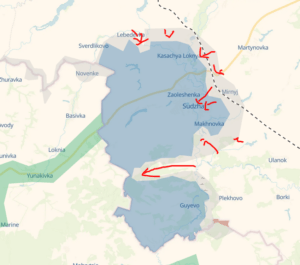
Next is a rough depiction of the Pokrovsk to Kupiansk defense/supply line (in blue). Notice that Russian forces--as opposed to even four or five months are pushing hard on the line in multiple spots.
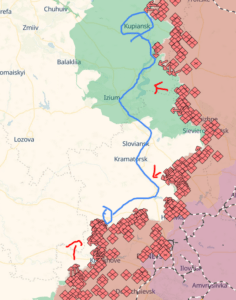
These "hot points" are seen in the north at Kupiansk (especially just north of Kupiansk, but also further south at Senkove and the Oskil waterway, but also Russian forces are laboring toward Borova. Keep in mind that the loss of Pokrovsk, for example, would cripple supplies further north (although these have clearly been disrupted) and that a massive amount of territory could thus be lost.
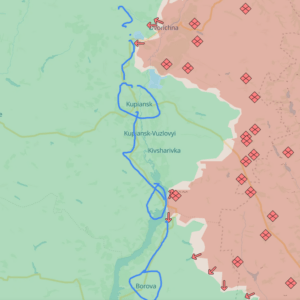
Further south to Pokrovsk is seen below, and here noteworthy is that Ukraine has had recent success at Toretsk and also, reportedly at Shevchenko, south of Pokrovsk--again revealing that Ukrainian troops on the ground, while depleted and exhausted, still potentially pack a punch.
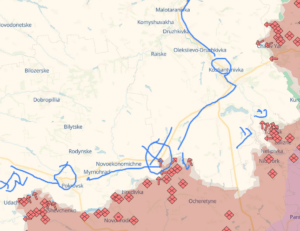

This especially appears to have been the case at Toretsk, with Russian bloggers seemingly in panic-hysteria over Ukrainian advances into the city (although some of these have not been independently confirmed).

That said, those are the only bright spots on the ground for Ukraine--and they are debatable. And with the collapse at Kursk, which appears to be accelerating by the hour, said bright spots may soon be a glimmer of the past.
And over the past year Ukraine has seen many, many such bright spots fade. The map below illustrates the current situation south of Pokrovsk with former Ukrainian holdings also marked in blue. And keep in mind that Ocheretyne, which may be described as a breaking point that began a series of Ukrainian pullbacks only culminated in March-April 2024. At that time Avdiivka and Marinka were still defended. Following Ocheretyne, these holdings were quickly lost.
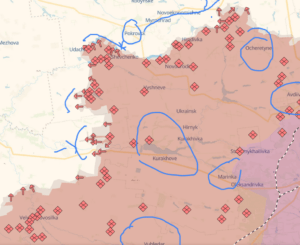
Which does lend credence to Trump's arguments. Ukraine is losing and it has been losing for quite some time. Desperately needed is an end to the war.
Which brings us back to the proposed ceasefire; to Trump calling Russia's bluff--or to Zelenskyy calling Russia's bluff. Or to Zelenskyy calling Trump and Russia's bluff.
For this correspondent is willing to bet that the Kursk catastrophe is all that Putin needs to keep going. As in no ceasefire at all--and in fact, there is no evidence that Russia has recently considered a ceasefire of any kind.
But--to play the devil's advocate--what would happen if Russia does give it lip service and delays? That answer is easy: Russian forces will continue to press and likely advance, and civilian targets will continue to be hit. But what if Russia does agree to a ceasefire, which ostensibly would mean a US-Ukrainian rare-elements mining deal, further US cooperation and "security" that supposedly would come with it.
First, that will last only 30 days--and it will give Russian forces a chance to rest, re-arm, regroup and bring in further reinforcements (and expect more North Koreans here. But there is an even potentially more dangerous scenario.
Trump will be hard pressed to get the "rare elements" side of the deal in place. This likely means a big rush in when it comes to US firms and at least contractors in the paid professional category to protect such investments. A la a Sierra Leone type of set up.
Yet this will not diminish US risk of getting dragged into a very direct conflict with Russia--primarily because that is the nature of such a wise-guy deal. The wise guy moves in as partner, and not only is he expected to protect the club, but now the club is partially his to protect. There is no relatively simple and diplomatic method to back out of said deal, as this is, as mentioned, not diplomacy. It becomes a partnership based on...
Business.
Supposedly worth billions.
And if that does not sound risky, I don't know what does.
Preston Smith is a licensed investigator based in Gdansk, Poland. He can be reached at query@cddi.pl.
Maps are courtesy of DeepStateUA.
Photo credit: The White House/public domain, courtesy of Wikimedia Commons.


